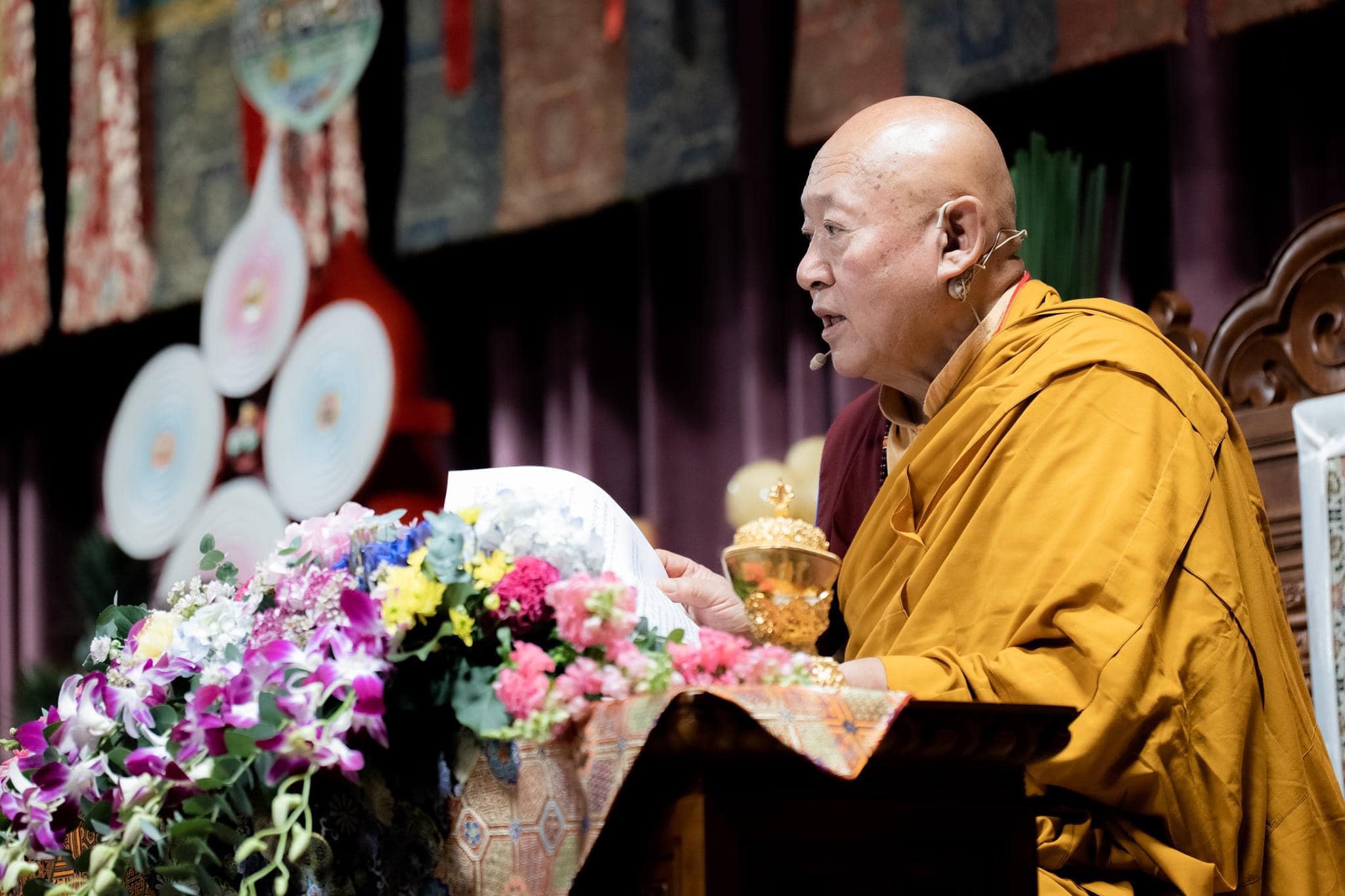Lhabab Duchen

November 7th, 2020, the 22nd of the 9th Tibetan month of the Iron Rat year, is Lhabab Duchen, a major festival that celebrates the Buddha’s descending from the Heaven of the Thirty-Three. It is also His Holiness Chokyi Nangwa’s 79th birthday. On this auspicious day, for the first time, His Holienss Chetsang hosted a commemoration of the Maha Parinirvana of Phagmodrupa, the guru of Lord Jigten Sumgon. His Holiness succinctly spoke of the life stories of Phagmodrupa:
“In 1110, Phagmodrupa was born in Kham, Tibet. In 1118, at age 9, Phagmodrupa became a monk at Chachig Lhakhang and started to study reading, writing, and learning the basics of Buddhism. In 1127, at age 18, Phagmodrupa received Chapa Chokyi Senge’s teachings on the Middle Way and Hetuvidya (science of causes) from Geshe Tolung Gyalma. At the same time, he received teachings on Bodhisattvacaryāvatāra (A Guide to the Bodhisattva’s Way of Life) from Geshe Nyanten. Phagmodrupa’s commentary on Bodhisattvacaryāvatāra can be found in The Collections of Phagmodrupa. This commentary has been translated into English and German. Its Chinese translation is under working progress and will soon be available to you all.



November 7th, 2020, the 22nd of the 9th Tibetan month of the Iron Rat year, is Lhabab Duchen, a major festival that celebrates the Buddha’s descending from the Heaven of the Thirty-Three. It is also His Holiness Chokyi Nangwa’s 79th birthday. On this auspicious day, for the first time, His Holienss Chetsang hosted a commemoration of the Maha Parinirvana of Phagmodrupa, the guru of Lord Jigten Sumgon. His Holiness succinctly spoke of the life stories of Phagmodrupa:
“In 1110, Phagmodrupa was born in Kham, Tibet. In 1118, at age 9, Phagmodrupa became a monk at Chachig Lhakhang and started to study reading, writing, and learning the basics of Buddhism. In 1127, at age 18, Phagmodrupa received Chapa Chokyi Senge’s teachings on the Middle Way and Hetuvidya (science of causes) from Geshe Tolung Gyalma. At the same time, he received teachings on Bodhisattvacaryāvatāra (A Guide to the Bodhisattva’s Way of Life) from Geshe Nyanten. Phagmodrupa’s commentary on Bodhisattvacaryāvatāra can be found in The Collections of Phagmodrupa. This commentary has been translated into English and German. Its Chinese translation is under working progress and will soon be available to you all.


“Phagmodrupa also received empowerment of the Sakya tradition from Sachen Kunga Nyingpo. Because Phagmodrup observed the Vinaya rules strictly, during the empowerment he did not drink nectar made of wine. Instead, he added brown sugar into water to replace wine. This tradition of making nectar by adding brown sugar to water instead of using wine has been passed down to Lord Jigten Sumgon.
“Phagmodrupa regarded all monastics as representations of the Buddha. He not only prostrated to senior monastics who granted refuge vows, but also to younger monastics as long as there were four of them together. In addition, Phagmodrupa ate strictly vegetarian food. Following Phagmodrupa’s example, Lord Jigten Sumgon was also a vegetarian.
“Phagmodrupa has also received teachings on Lamdre (Path and Its Fruit) from from Sachen Kunga Nyingpo. His commentary on Lamdre is also included in the Collections of Phagmodrupa. I hope that one day this commentary can be translated to and published in Chinese too. In addition, Phagmodrupa has received teachings on Chakrasambava from Gar Lotsawa.
“Phagmodrupa has also received teachings on Lamdre (Path and Its Fruit) from from Sachen Kunga Nyingpo. His commentary on Lamdre is also included in the Collections of Phagmodrupa. I hope that one day this commentary can be translated to and published in Chinese too. In addition, Phagmodrupa has received teachings on Chakrasambava from Gar Lotsawa.
“In 1151, at age 42, Phagmodrupa met Dagpo Rinpoche Gampopa. Gampopa has received teachings of the Kadam tradition from Lord Atisha as well as teachings of the Kagyu tradition from Milarepa, which has been passed down from Tilopa, Naropa, and etc. In this way, the teaching lineage and the blessing lineage merged in Gampopa and became Dagpo Kagyu. In history, this is called ‘teachings and mudra, two streams merged into one(བཀའ་ཕྱག་ཆུ་བོ་གཉིས་འདྲེས་)’. This merged lineage is what Phagmodrupa has received from Gampopa.


“According to Jamgon Kongtrul Yonten Gyatso (the first Jamgon Kongrul Rinpoche)’s documentation, four lineages derived from Gampopa: Darma Wangchug’s Barom Kagyu, Phagmodrupa Dorje Gyalpo’s Phagdru Kagyu, Dusum Khyenpa, the first Karmapa’s Karma Kagyu, and Tsalpa Lama Zhang’s Tsalpa Kagyu.
“Again, according to Jamgon Kongtrul’s documentation, eight lineages derived from Phagmodrupa, ‘Dri(Drikung), Tak(Taklung), Tro(Trophu), Ling(Lingre), Mar(Martsang), Yel(Yelpa), Ya(Yasang), and Shuk(Shuksep), are the Four Pairs and Eight Singles(ཟུང་བཞི་ཡ་བརྒྱད་)’. Drikung Kagyu, Drukpa Kagyu (Lingre Kagyu), and Taklung Kagyu are included in the Four Pair and Eight Singles.
“In 1170, on the 25th of the 9th Tibetan month in the Iron Tiger year, at age 60, Phagmodrupa passed into Maha Parinirvana. Today, we gathered together to celebrate the Maha Parinirvana of Phagmodrupa and practice his guru yoga. ”

